

Cadence KAL: Finishing your Knit! « KristenMakes. OK, so my Cadence is done being knitted, but it still looks messy.
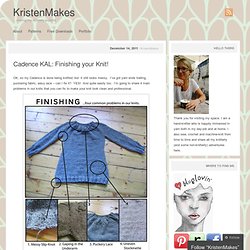
I’ve got yarn ends trailing, puckering fabric, wavy lace – can I fix it? YES! And quite easily too. I’m going to share 4 main problems in our knits that you can fix to make your knit look clean and professional. The Thumb Trick: Sometimes called an afterthought thumb, I first read about it in Elizabeth Zimmermann's Knitter's Almanac.

I really like this method because it's seamless; sometimes when patterns have you place stitches on a holder and then cast on the top stitches you can get an odd seam right in the crease where your thumb meets the hand, and that can be uncomfortable. The only trouble that some people may have with this method is that you cannot immediately try on your mitten in progress, as you can with mittens where the stitches are put on holders. Adding a new ball of yarn in the same color. Today: "Joining yarn," or "What to do when you're at the tail end of the old ball of yarn, and you need to add in a new ball of the same color.
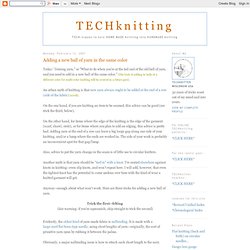
" (The trick of adding in balls of a different color for multi-color knitting will be covered in a future post). An urban myth of knitting is that new yarn always ought to be added at the end of a row (side of the fabric) (scroll). On the one hand, if you are knitting an item to be seamed, this advice can be good (see trick the third, below). On the other hand, for items where the edge of the knitting is the edge of the garment (scarf, shawl, stole), or for items where you plan to add an edging, this advice is pretty bad.
Adding yarn at the end of a row can leave a big loopy gap along one side of your knitting, and/or a lump where the ends are worked in. Also, advice to put the yarn change in the seam is of little use to circular knitters. Another myth is that yarn should be "tied in" with a knot. Anyway--enough about what won't work. Click picture. BACK to the back join. The back join (subject of a previous post) is a method for working in the tails AS YOU GO in multi-color knitting.
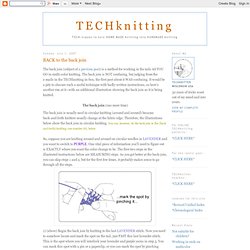
The back join is NOT confusing, but judging from the e-mails in the TECHknitting in-box, the first post about it WAS confusing. It would be a pity to obscure such a useful technique with badly-written instructions, so here's another run at it--with an additional illustration showing the back join as it is being knitted. Steeking with crochet binding. Thank you to everyone who entered the Coastal Knits contest.
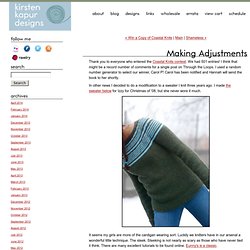
We had 501 entries! I think that might be a record number of comments for a single post on Through the Loops. I used a random number generator to select our winner, Carol P! Carol has been notified and Hannah will send the book to her shortly. Weaving in Ends. I have some good news.

And, I have some bad news. Good news first: there is no one right way to weave in your ends. So, chances are, you haven’t been doing it wrong! Now, the bad news: there are so many different ways to weave in your ends, you might not be doing it the best way either. Having options, it’s a blessing and a curse. Some of our most seasoned customers would come in to find a knitting newbie at the communal table, finishing up a project in some newfangled kind of way.
k1p1 invisible bind-off tutorial « crankygrrrrrl. This being my first real adventure in toe-up socks, i was a loss as to what bind off to use. sensational knitted socks didn’t have a recommended bind-off (did it?)

…and i’ve read enough blogs to know that i needed something stretchy. a quick google search didn’t turn up much, although i did rediscover laurie b’s toes and heels webpage (it’s a fantastic collection of links for different toe and heel techniques…thanks!). Short Rows: Shadow Wraps. Over the last couple weeks I’ve reviewed the plain wrap, the yarn over wrap, the Japanese wrap, and the double stitch wrap.
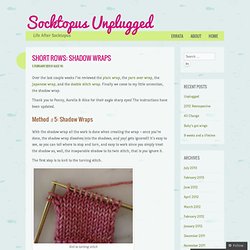
Finally we come to my little unvention, the shadow wrap. Thank you to Penny, Aurelia & Alice for their eagle sharp eyes! The instructions have been updated. Cast On: Provisional. A provisional cast-on keeps cast-on stitches "live" so that they can be knit later.
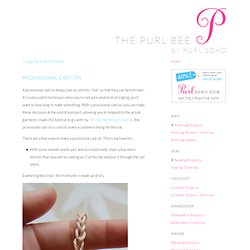
It's a very useful technique when you're not sure what kind of edging you'll want or how long to make something. Picking up along a garter edge. Pick-up Lines.
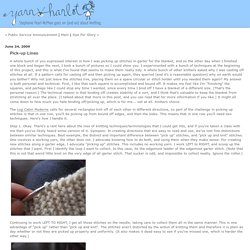
Charisa_martin: How to Knit a Welt, a Ridge, a Pintuck: Texture! Welt, Ridge, Pintuck: How ToA knitted welt adds texture and definition to your knitting. You can do it small, you can do it large. It's easy.